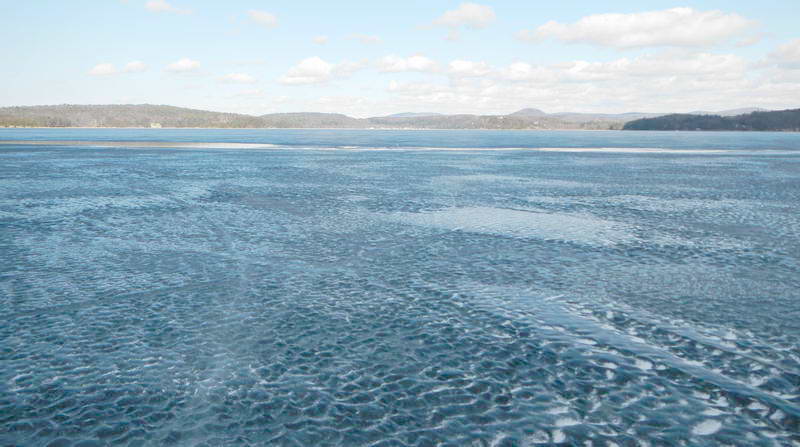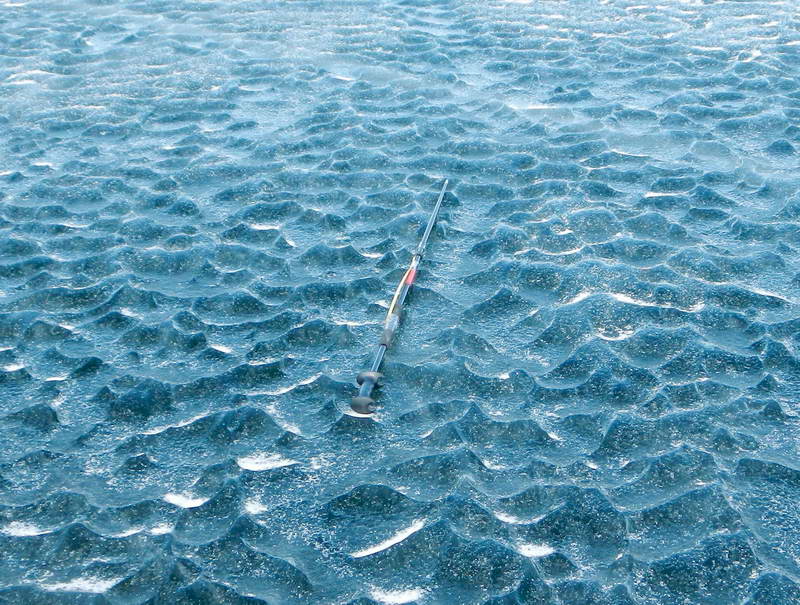Wind Scalloping
 Picture taken a couple inches above the ice, skating pole for scale.
Picture taken a couple inches above the ice, skating pole for scale.
A sustained, warm, strong wind can make large areas of an ice sheet quite rough for skating, sailing and even walking. Wind Scallops are typically 3 to 6" across and 1/2 to 1+" deep. The formation mechanism appears to be from eddies that form on the downwind side of small ridges (or grooves?) in the ice. Once started, they make their own ridges. They can be mostly separated from each other or they can overlap when the conditions are intense and sustained enough. They appear to get bigger at higher wind speeds. The wind speeds in this case were 20-30 mph sustained with higher gusts up to 40 mph. The air temperatures held in the upper 50's for about 1-1/2 days.
A screen capture from http://www.wunderground.com. The scolloping started on early Wednesday 3/7/12. The pictures were taken late in the day on Friday, 3/9.
Ice loss in scallop formation is due to a combination of melting and evaporation. Melt water can drain through pores in the well thawed ice sheet. Evaporation may be the more significant factor given the high wind speeds and air temperature. The scallops are similar to scallops found on hard rocks in very strong rapids.
 A couple miles of wind scalloped ice on inner Mallets Bay VT. Note the band of open water from a melted out ridge.
A couple miles of wind scalloped ice on inner Mallets Bay VT. Note the band of open water from a melted out ridge.
They typically are more frequent and larger away from a windward shore. They tend to be more developed in areas where the wind is intensified such as around points of land. Very large areas can be affected so it is wise to not expect things to get better if you just go far enough (an approach that often works for cobblestone ice). The best method for avoiding scalloped ice is stay on windward shores that are often protected somewhat from the strongest winds coming off the land. The downwind side of a pressure ridge might offer a smoother path although keep in mind that it is likely that, in these conditions, ridges may be completely melted away making them uncrossable and not offering much of a wind break for the ice sheet. In general, conditions that are warm and windy enough to scallop the surface are also likely to create many other problems with the ice sheet.
 Heavily scalloped ice: pole for scale
Heavily scalloped ice: pole for scale
Wind scalloped ice appears to be a variation of cobblestone ice and their effect on skaters and sailors is similar. Cobblestone ice appears to be associated with a grain size averaging about 4". Wind Scalloping occurs on any type of ice, regardless of grain size. In these same conditions, snow drifts tend to get sculpted by strong winds as they melt away. Scolloping events often occur late in the season and, for the past two years, these events effectively ended the sailing and skating seasons on Lake Champlain.
Bob
Updated 6/22/13

